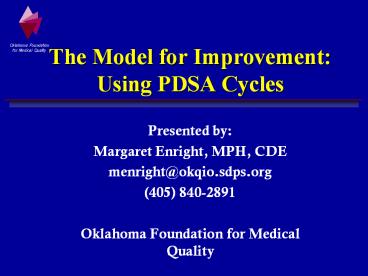The Model for Improvement: Using PDSA Cycles - PowerPoint PPT Presentation
1 / 19
Title:
The Model for Improvement: Using PDSA Cycles
Description:
Oklahoma Foundation for Medical Quality ... ( Predict increased examination rate.) Do: Nurses are taught monofilament exam technique. Exams on 20 patients completed. ... – PowerPoint PPT presentation
Number of Views:967
Avg rating:3.0/5.0
Title: The Model for Improvement: Using PDSA Cycles
1
The Model for ImprovementUsing PDSA Cycles
- Presented by
- Margaret Enright, MPH, CDE
- menright_at_okqio.sdps.org
- (405) 840-2891
- Oklahoma Foundation for Medical Quality
2
Model for Improvement
What are we trying to
accomplish?
How will we know that a
change is an improvement?
What change can we make that
will result in improvement?
3
Use the PDSA Cycle to
- Help answer the first two questions of the model
- Develop a plan for change
- Test a change
- Implement a change
- Evaluate the change
- Decide on Next Steps, based on experience
4
The PDSA Cycle for Learning and Improvement
Act
Plan
- What changes
- are to be made?
- Next cycle?
- Adopt, adapt,
- or abandon??
- Objective
- Questions and
- predictions (why)
- Plan to carry out
- the cycle (who,
- what, where, when)
Study
Do
- Complete the
- analysis of the data
- Compare data to
- predictions
- Summarize what
- was learned
- Carry out the plan
- Document problems
- and unexpected
- observations
- Begin analysis
- of the data
5
Rapid Cycle Change (Repeated Use of the Cycle)
Changes That Result in Improvement
DATA
DIFFICULTY
Hunches Theories Ideas
TIME
6
The PDSA Cycle for Learning and Improvement
Changes that result in improvement
DATA
Cycle 5 Spread to other physicians, units, etc.
Cycle 4 Implementation of system change(s)
Cycle 3 Wider scale tests of change
Hunches, theories, ideas
Cycle 2 Follow up Tests with larger study group
Cycle 1 Very Small Scale Test
7
How Do We Know That A Change is an Improvement?
- Are specific measures tested during the pdsa
cycles demonstrating desired results? - Does the change facilitate the overall goal(s) of
the practice? - Can this change be attained (and maintained)
without undue interference with other important
practice goals?
8
Aim Improve Blood Sugar Levels of the Population
of Patients w/Diabetes
Proactive glycemic control an integral part of
the system
DATA
Cycle 5 Implement protocol (w/needed
alterations) system wide
Cycle 4 Test protocol with additional units
Cycle 3 Test protocol with one physician unit
Develop successful approaches to improve glycemic
control
Cycle 2 Establish draft protocol for HgbA1C
testing and targeted treatment
Cycle 1Develop system for regularly obtaining
and tracking HgbA1Cs
9
Plan
- State the Objective of the plan
- Plan the Change (what, who, when, where?)
- Predictions (what is expected to happen?)
- Data Collection (who,what,when, where?)
10
Do
- Carry out the change/test and begin data
collection and analysis- - What will actually be tested?
- What happens?
- Additional observations
- Were there unexpected problems/barriers?
11
Study
- Complete analysis of the data
- Summarize what was learned
- Compare data to predictions
12
Act
- (This step of the cycle could also be called the
accept, adapt, or abandon step) - Should we make changes in the plan prior to the
next test cycle? - Are we ready to implement the change and plan for
spread of the change??
13
Skills Which Support Real Improvement
- Challenge the boundaries (creative thinking)
- Visualize the ideal
- Remove the current way of doing things as an
option (think outside the box) - Always go back to the overall practice goals to
guide the PDSA cycles
14
Example PDSA Cycle for Delivery System Design
Change
- Plan Five office nurses will perform complete
foot screenings on diabetes patients. (Predict
increased examination rate.) - Do Nurses are taught monofilament exam
technique. Exams on 20 patients completed. - Study Patients were accepting, nurses competent
to perform exams, increase from 33 to 67 in
foot screenings accomplished, abnormal exams
referred appropriately - Act Expand to all diabetes patients. Expand to
remaining nursing staff.
15
Common Reasons for Failed PDSA Cycle Tests
- The plan for change is not well executed
- The pilot test subjects are not early adopters
- The support processes are not adequate
- The original hypothesis/prediction is wrong
16
Successful Cycles typically
- Start small
- Involve early adopters who believe that the
change can create improvement - Have the general support of the leadership
- Dont get bogged down in collecting mountains of
data, but concentrate only on useful, pertinent
data
17
To Accelerate Improvement
- Develop focused, important objectives
- Strive for usefulness in the data collection and
analysis - To obtain buy in begin with evidence-based
goals - Test first on a small scale and spread the good
or well-adapted plans for change
18
Useful Strategies to Hold the Gains
- Establish and document new processes
- Make formal changes to job descriptions
- Use regular measurements and audits
- Factor new goals/processes into staff training
and new hire orientation - Assign ownership of new processes
- Address the social aspects of change
19
Important to Address the Social Aspects of
Change
- Provide and disseminate widely information on why
the change is being adopted - Give specific information on how the change will
affect people - Seek and use input from others, (especially those
directly affected by the change), and encourage
their support - Publicize the PDSA results and what was learned
from them - Understand and address the causes of resistance
to change































